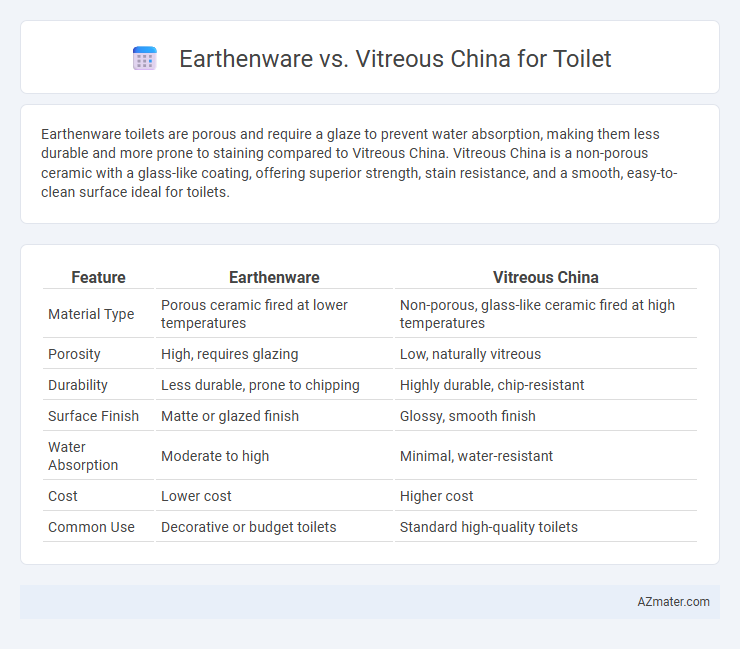Earthenware toilets are porous and require a glaze to prevent water absorption, making them less durable and more prone to staining compared to Vitreous China. Vitreous China is a non-porous ceramic with a glass-like coating, offering superior strength, stain resistance, and a smooth, easy-to-clean surface ideal for toilets.
Table of Comparison
| Feature | Earthenware | Vitreous China |
|---|---|---|
| Material Type | Porous ceramic fired at lower temperatures | Non-porous, glass-like ceramic fired at high temperatures |
| Porosity | High, requires glazing | Low, naturally vitreous |
| Durability | Less durable, prone to chipping | Highly durable, chip-resistant |
| Surface Finish | Matte or glazed finish | Glossy, smooth finish |
| Water Absorption | Moderate to high | Minimal, water-resistant |
| Cost | Lower cost | Higher cost |
| Common Use | Decorative or budget toilets | Standard high-quality toilets |
Introduction to Toilet Materials: Earthenware vs Vitreous China
Earthenware toilets, made from porous clay fired at lower temperatures, offer a traditional, cost-effective option with a natural look but require glazing to prevent water absorption and staining. Vitreous china, a type of porcelain fired at higher temperatures and coated with a glass-like enamel, provides superior durability, non-porosity, and resistance to scratches and chemicals, making it the most common material choice for modern toilets. The choice between earthenware and vitreous china impacts the toilet's performance, longevity, and maintenance requirements.
Understanding Earthenware: Composition and Properties
Earthenware toilets are made from porous clay fired at lower temperatures, resulting in a less dense and more absorbent material compared to Vitreous China. This composition makes earthenware more prone to chipping and staining but offers a rustic, traditional appearance often favored in certain interior designs. The inherent porosity requires a strong glaze to ensure water resistance and hygiene, emphasizing the importance of glaze quality in earthenware toilet durability and maintenance.
What is Vitreous China? Key Features and Benefits
Vitreous China is a ceramic material coated with a glass-like enamel that makes it highly durable, non-porous, and resistant to stains and scratches, distinguishing it from earthenware. Its smooth, glossy surface enhances hygiene by preventing bacterial growth and facilitates easy cleaning. Popular in toilets, Vitreous China offers long-lasting strength and a sleek aesthetic, making it a preferred choice for bathrooms requiring both functionality and style.
Durability and Strength Comparison
Earthenware toilets are less durable and more porous compared to vitreous china, making them more prone to chips, cracks, and stains over time. Vitreous china is coated with a glass-like enamel that enhances strength, resists scratches, and provides a non-porous surface, resulting in superior longevity and easier maintenance. The superior durability of vitreous china makes it the preferred material for high-traffic bathrooms and commercial installations.
Porosity and Water Absorption Differences
Earthenware toilets exhibit higher porosity, resulting in increased water absorption compared to vitreous china, which is characterized by its dense, non-porous surface due to vitrification. The reduced porosity of vitreous china enhances durability and hygiene by minimizing water retention and inhibiting bacterial growth. Consequently, vitreous china is preferred for toilets as it provides a more sanitary, stain-resistant, and long-lasting finish than earthenware.
Cleaning and Maintenance Considerations
Earthenware toilets feature a porous surface prone to staining and require more frequent scrubbing with non-abrasive cleaners to prevent buildup. Vitreous china offers a smooth, glass-like finish that resists stains and mineral deposits, making it easier to clean with mild detergents and reducing long-term maintenance. Choosing vitreous china can enhance hygiene and durability while minimizing the effort and frequency of cleaning.
Aesthetic Appeal and Design Choices
Earthenware toilets feature a porous surface with a matte finish, offering a traditional and rustic aesthetic that complements classic bathroom styles and vintage interiors. Vitreous china toilets provide a smooth, glossy finish with a non-porous glaze, enhancing the visual appeal through a sleek, modern look that fits well in contemporary and minimalist designs. Design choices between the two materials depend on desired bathroom ambiance, with earthenware emphasizing warmth and texture, while vitreous china prioritizes cleanliness and shine for a polished appearance.
Cost Analysis: Earthenware vs Vitreous China Toilets
Earthenware toilets typically cost 20-30% less than vitreous china models due to lower manufacturing expenses and raw material costs. Vitreous china offers superior durability and stain resistance, which can reduce long-term maintenance and replacement costs despite a higher initial price. Budget-conscious buyers often prefer earthenware for short-term use, while vitreous china provides better value in high-traffic or commercial settings.
Environmental Impact and Sustainability
Earthenware toilets typically consume more raw materials and energy during production compared to vitreous china, leading to a higher environmental footprint. Vitreous china, due to its denser, glazed finish, tends to be more durable and less prone to cracks or leaks, which reduces water wastage and extends the lifespan of the product. Selecting vitreous china toilets supports sustainability goals by minimizing resource consumption over time and promoting long-term efficiency in water usage.
Which Toilet Material is Right for You?
Earthenware toilets offer a classic, cost-effective option with a porous surface that requires regular sealing to prevent stains and odors, making them suitable for low-traffic bathrooms. Vitreous china toilets feature a glass-like, non-porous coating that ensures durability, stain resistance, and easy cleaning, ideal for high-usage areas where hygiene is paramount. Choosing the right toilet material depends on balancing budget, maintenance effort, and long-term performance needs.

Infographic: Earthenware vs Vitreous China for Toilet
 azmater.com
azmater.com